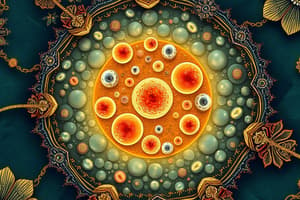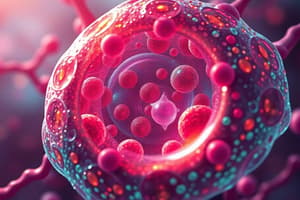Podcast
Questions and Answers
Describe the function of the Golgi apparatus and explain why it is important for cell function.
Describe the function of the Golgi apparatus and explain why it is important for cell function.
The Golgi apparatus modifies, sorts, and packages proteins and lipids received from the endoplasmic reticulum (ER). It is essential for cell function as it ensures that these molecules are properly processed and delivered to their correct destinations within the cell or for secretion outside the cell.
What is the difference between rough endoplasmic reticulum (ER) and smooth ER? Explain their respective roles in the cell.
What is the difference between rough endoplasmic reticulum (ER) and smooth ER? Explain their respective roles in the cell.
Rough ER is studded with ribosomes, which are responsible for protein synthesis. Smooth ER lacks ribosomes and is involved in lipid synthesis, detoxification, and calcium storage. Rough ER produces proteins that contribute to the cell's structure and function, while smooth ER helps maintain cell membrane integrity and detoxifies harmful substances.
Explain the role of the cytoskeleton in maintaining cell shape and facilitating cell movement.
Explain the role of the cytoskeleton in maintaining cell shape and facilitating cell movement.
The cytoskeleton is a network of protein filaments that provides structural support and enables cell movement. It helps maintain cell shape, assists in the transport of organelles and vesicles within the cell, and facilitates cell motility through processes like cilia or flagella movement.
Compare and contrast the structure and function of the nucleus and nucleolus.
Compare and contrast the structure and function of the nucleus and nucleolus.
Describe the function of the cell membrane and explain its importance in maintaining cell integrity.
Describe the function of the cell membrane and explain its importance in maintaining cell integrity.
What are the unique organelles found in plant cells, and what are their functions?
What are the unique organelles found in plant cells, and what are their functions?
Explain why mitochondria are often referred to as the 'powerhouse of the cell.'
Explain why mitochondria are often referred to as the 'powerhouse of the cell.'
Describe the function of lysosomes and explain their importance in maintaining cellular health.
Describe the function of lysosomes and explain their importance in maintaining cellular health.
Describe the function of the lysosome and how its structure contributes to this function.
Describe the function of the lysosome and how its structure contributes to this function.
Explain the role of ribosomes in protein synthesis.
Explain the role of ribosomes in protein synthesis.
What is the function of the cell wall in plant cells?
What is the function of the cell wall in plant cells?
Describe the process of facilitated diffusion and how it differs from simple diffusion.
Describe the process of facilitated diffusion and how it differs from simple diffusion.
Explain the difference between isotonic, hypertonic, and hypotonic solutions.
Explain the difference between isotonic, hypertonic, and hypotonic solutions.
What is the role of the cell membrane in maintaining homeostasis?
What is the role of the cell membrane in maintaining homeostasis?
Describe the structure of a phospholipid and explain how its structure allows it to form the cell membrane.
Describe the structure of a phospholipid and explain how its structure allows it to form the cell membrane.
Explain how the Golgi apparatus processes and packages proteins.
Explain how the Golgi apparatus processes and packages proteins.
What is the difference between endocytosis and exocytosis?
What is the difference between endocytosis and exocytosis?
Explain the difference between phagocytosis and pinocytosis.
Explain the difference between phagocytosis and pinocytosis.
Describe the role of the rough endoplasmic reticulum (RER) in protein synthesis.
Describe the role of the rough endoplasmic reticulum (RER) in protein synthesis.
Explain the role of the chloroplast in plant cells.
Explain the role of the chloroplast in plant cells.
Describe the function of the vacuole in plant cells.
Describe the function of the vacuole in plant cells.
Explain how the concentration gradient drives diffusion.
Explain how the concentration gradient drives diffusion.
What are the functions of the base, stage, and objective lenses on a microscope?
What are the functions of the base, stage, and objective lenses on a microscope?
What is the formula to find the total magnification of a microscope?
What is the formula to find the total magnification of a microscope?
How would you calculate the Field of View (FOV) in micrometers from a measurement in millimeters?
How would you calculate the Field of View (FOV) in micrometers from a measurement in millimeters?
If the diameter of the FOV on low power is measured as 2 mm, what is the diameter in micrometers?
If the diameter of the FOV on low power is measured as 2 mm, what is the diameter in micrometers?
What steps should you follow to create a cell drawing under a microscope?
What steps should you follow to create a cell drawing under a microscope?
How do you determine the diameter of a specimen that occupies one-third of the FOV?
How do you determine the diameter of a specimen that occupies one-third of the FOV?
Flashcards
Nucleus
Nucleus
The control center of the cell, containing DNA and regulating gene expression.
Nucleolus
Nucleolus
Makes ribosomes and proteins, located inside the nucleus.
Nuclear Membrane/Envelope
Nuclear Membrane/Envelope
The barrier that separates the nucleus' contents from the cytoplasm, allowing selective passage of molecules.
Mitochondria
Mitochondria
Signup and view all the flashcards
Golgi Apparatus
Golgi Apparatus
Signup and view all the flashcards
Cytoskeleton
Cytoskeleton
Signup and view all the flashcards
Cell Membrane
Cell Membrane
Signup and view all the flashcards
Cell Wall
Cell Wall
Signup and view all the flashcards
Microscope Magnification
Microscope Magnification
Signup and view all the flashcards
Field of View (FOV)
Field of View (FOV)
Signup and view all the flashcards
FOV Low
FOV Low
Signup and view all the flashcards
FOV Medium
FOV Medium
Signup and view all the flashcards
Cell Drawing
Cell Drawing
Signup and view all the flashcards
Large central vacuole
Large central vacuole
Signup and view all the flashcards
Lysosome
Lysosome
Signup and view all the flashcards
Cytoplasm
Cytoplasm
Signup and view all the flashcards
Chloroplasts
Chloroplasts
Signup and view all the flashcards
Centrioles
Centrioles
Signup and view all the flashcards
Passive Transport
Passive Transport
Signup and view all the flashcards
Active Transport
Active Transport
Signup and view all the flashcards
Diffusion
Diffusion
Signup and view all the flashcards
Concentration gradient
Concentration gradient
Signup and view all the flashcards
Osmosis
Osmosis
Signup and view all the flashcards
Isotonic solution
Isotonic solution
Signup and view all the flashcards
Hypertonic solution
Hypertonic solution
Signup and view all the flashcards
Hypotonic solution
Hypotonic solution
Signup and view all the flashcards
Study Notes
Animal and Plant Cell Structure
- Animal cells are typically round or irregular in shape, while plant cells are square or rectangular.
- Plant cells have unique organelles not found in animal cells, such as cell walls, chloroplasts, and a large central vacuole.
- Animal cells contain centrioles and centrosomes, and lysosomes.
- Both plant and animal cells share many of the same organelles.
Organelles and Their Function
- Nucleus: Contains DNA, regulates gene expression, controls cell activities and reproduction. Large, sphere-shaped. Found in both plant and animal cells.
- Nucleolus: Makes ribosomes and proteins. Located inside the nucleus, sphere-shaped. Found in both plant and animal cells.
- Nuclear membrane/envelope: Separates nucleus from cytoplasm. Surrounds the nucleus. Found in both plant and animal cells.
- Nuclear pore: Allows small molecules and ions to pass into or out of the nucleus. Small circle/dots on the nuclear membrane. Found in both plant and animal cells.
- Chromatin: Packages DNA for fitting within the nucleus. Spaghetti-like structure inside the nucleus (not the nucleolus). Found in both plant and animal cells.
- Ribosomes: Make amino acids. Found on the rough ER, shaped like a circle or hamburger. Found in both plant and animal cells.
- Rough ER: Turns amino acids into polypeptide chains (protein synthesis). Long, oval-like, weirdly shaped tubes. Found in both plant and animal cells.
- Smooth ER: Makes lipids and helps with drug/toxin processing. Lots of circular tubes. Found in both plant and animal cells.
- Mitochondria: Produces ATP (energy) by converting glucose. Oval-shaped with folded interior (squiggly lines). Found in both plant and animal cells.
- Golgi apparatus: Modifies, sorts, and packages proteins and lipids from the ER; stack of hollow pancakes turned sideways. Found in both plant and animal cells.
- Peroxisome: Breaks down fatty acids and amino acids; detoxifies harmful substances. Ball-shaped with smaller internal spheres. Found in both plant and animal cells.
- Cytoskeleton: Provides structural support and cell movement (made of microfilaments, intermediate filaments, and microtubules). Long, bone-shaped structures. Found in both plant and animal cells.
- Cell Membrane: Regulates what enters and exits the cell; semi-permeable. Double layer (two lines) with things in between, like a railroad track. Found in both plant and animal cells.
- Vacuoles: Stores nutrients and waste; maintains turgor pressure in plants. Water droplet structures. Found in both plant and animal cells.
- Large central vacuole: Same as a regular vacuole, much larger, and found only in plant cells. Massive, smooth shape.
- Centrioles: Involved in cell division. Barrel-shaped. Found in animal cells, not plant cells.
- Lysosome: Contains digestive enzymes that break down waste. Ball-shaped with smaller internal spheres. Found in animal cells, not plant cells
- Cell wall: Rigid outer layer, provides structural support and protection (primarily cellulose). Barrier surrounding the cell. Found in plant cells, not animal cells.
- Chloroplasts: Sites of photosynthesis (convert light energy into chemical energy). Smooth, round oval/disk shape. Found in plant cells, not animal cells.
- Cytoplasm: Jelly-like substance filling the cell; site of biochemical reactions; holds organelles in place.
Protein Synthesis
- Instructions for protein synthesis are in the nucleus (DNA).
- Ribosomes translate mRNA into amino acids and polypeptide chains.
- Rough endoplasmic reticulum (RER) modifies polypeptide chains.
- Golgi apparatus processes and packages proteins.
- Transport vesicles carry proteins to their destinations.
Cell Membrane
- Homeostasis: Self-regulating process to maintain stability.
- Semi-permeable membrane: Some things can enter/exit.
- Hydrophobic: Repels water.
- Hydrophilic: Attracted to water.
- Phospholipids: Make up the cell membrane bilayer (hydrophilic head, hydrophobic tail).
- Brownian motion: Constant molecular movement (unless at absolute zero).
- Passive transport: Movement without energy expenditure.
- Active transport: Movement with energy expenditure.
- Diffusion: Movement from high to low concentration.
- Concentration gradient: Difference in concentration between areas.
- Osmosis: Diffusion of water across a semi-permeable membrane.
- Isotonic solution: Equal concentrations inside and outside the cell.
- Hypertonic solution: Higher concentration outside the cell.
- Hypotonic solution: Lower concentration outside the cell.
- Facilitated diffusion: Diffusion with protein channels.
- Endocytosis: Bringing substances into the cell.
- Exocytosis: Removing substances from the cell.
- Phagocytosis: Bringing solids into the cell.
- Pinocytosis: Bringing liquids into the cell.
- Simple diffusion: Small molecules passing through phospholipid bilayer.
- Facilitated diffusion: Movement via protein channels
Microscopes
- Base, arm, stage, objective lenses, eyepiece (ocular lens), coarse adjustment knob, fine adjustment knob, illuminator, condenser, diaphragm, revolving nosepiece, body tube.
- Microscope magnification table is provided with calculations to find the FOV, given magnification and specimen width.
Cell Drawings
- Include a title, magnification, a perfect circle for FOV, labeled organelles, and use pencil and proper shading techniques (stippling).
Studying That Suits You
Use AI to generate personalized quizzes and flashcards to suit your learning preferences.




